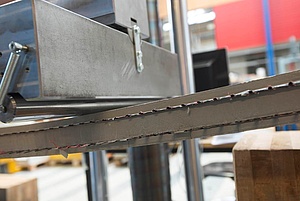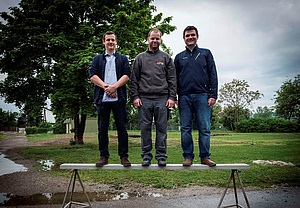Franz Xaver Forstlechner
Franz Xaver Forstlechner (2014), Thin-Walled Supporting Structures Made of Carbon-Concrete: Contribution to Improve Resource-Efficiency of Structural-Concrete, Institute of Structural Design; 1st reviewer: Stefan Peters, 2nd reviewer: Viet Tue Nguyen; 150 pages, German.
Due to the development of high-performance concrete types with enormous mechanical strengths, high durability and reliably adjustable consistency, it is possible to fabricate structural concrete elements with a thickness of just a few centimetres today. Also, the development of corrosion-resistant and high-strength reinforcement made of carbon-fibres favours this tendency, since it allows concrete-covers within a few millimetres. Therefore, the central research-question of this doctoral thesis is how thin concrete slabs with a maximum thickness of five centimetres should be reinforced in order to attain both, a high flexural stiffness under service load, and a high bending load capacity and ductility? The method of solution followed in the context of this work is to reinforce the concrete with laid webs made of carbon-fibres, which are placed as close as possible to the surface, and to add centric tendons in the areas of greatest stresses, which are pre-stressed in tensioning-bed. To answer the research question, laboratory tests are performed in order to investigate the bond-behaviour of carbon-reinforcement and high-performance concrete, and to investigate the bending-behaviour of loosely reinforced and pre-stressed carbon-concrete slabs. Based on the obtained test results, a model is created to describe the structural behaviour, and dimensioning recommendations are derived. Furthermore, the feasibility of the developed lightweight construction method is verified on larger scale by manufacturing a prototype, which provides knowledge about the suitable construction method, the economic efficiency, and about the long-term behaviour. The presented work is a building-practical contribution to the development of thin-walled structures made of carbon-concrete, which should increase the resource-efficiency of structural concrete because of its low own-weight and high durability.
Due to the development of high-performance concrete types with enormous mechanical strengths, high durability and reliably adjustable consistency, it is possible to fabricate structural concrete elements with a thickness of just a few centimetres today. Also, the development of corrosion-resistant and high-strength reinforcement made of carbon-fibres favours this tendency, since it allows concrete-covers within a few millimetres. Therefore, the central research-question of this doctoral thesis is how thin concrete slabs with a maximum thickness of five centimetres should be reinforced in order to attain both, a high flexural stiffness under service load, and a high bending load capacity and ductility? The method of solution followed in the context of this work is to reinforce the concrete with laid webs made of carbon-fibres, which are placed as close as possible to the surface, and to add centric tendons in the areas of greatest stresses, which are pre-stressed in tensioning-bed. To answer the research question, laboratory tests are performed in order to investigate the bond-behaviour of carbon-reinforcement and high-performance concrete, and to investigate the bending-behaviour of loosely reinforced and pre-stressed carbon-concrete slabs. Based on the obtained test results, a model is created to describe the structural behaviour, and dimensioning recommendations are derived. Furthermore, the feasibility of the developed lightweight construction method is verified on larger scale by manufacturing a prototype, which provides knowledge about the suitable construction method, the economic efficiency, and about the long-term behaviour. The presented work is a building-practical contribution to the development of thin-walled structures made of carbon-concrete, which should increase the resource-efficiency of structural concrete because of its low own-weight and high durability.


